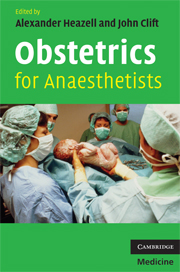Book contents
- Frontmatter
- Contents
- List of contributors
- Foreword
- Preface
- Acknowledgements
- List of abbreviations
- 1 Maternal physiology and obstetrics
- 2 Antenatal care
- 3 Induction of labour
- 4 Normal labour
- 5 Abnormal labour
- 6 Fetal monitoring
- 7 Pre-eclampsia and hypertensive disorders of pregnancy
- 8 Operative obstetrics
- 9 Obstetric haemorrhage
- 10 Thromboembolic disorders of pregnancy
- 11 Infection
- 12 Life support in obstetrics
- 13 Drugs in obstetrics
- 14 Confidential enquiries into fetal, neonatal and maternal death
- Appendix 1 Adult Advanced Life Support Algorithm
- Appendix 2 The Management of Postpartum Haemorrhage Algorithm
- Appendix 3 Emergency Management of Eclamptic Fit Algorithm
- Index
- References
1 - Maternal physiology and obstetrics
Published online by Cambridge University Press: 21 August 2009
- Frontmatter
- Contents
- List of contributors
- Foreword
- Preface
- Acknowledgements
- List of abbreviations
- 1 Maternal physiology and obstetrics
- 2 Antenatal care
- 3 Induction of labour
- 4 Normal labour
- 5 Abnormal labour
- 6 Fetal monitoring
- 7 Pre-eclampsia and hypertensive disorders of pregnancy
- 8 Operative obstetrics
- 9 Obstetric haemorrhage
- 10 Thromboembolic disorders of pregnancy
- 11 Infection
- 12 Life support in obstetrics
- 13 Drugs in obstetrics
- 14 Confidential enquiries into fetal, neonatal and maternal death
- Appendix 1 Adult Advanced Life Support Algorithm
- Appendix 2 The Management of Postpartum Haemorrhage Algorithm
- Appendix 3 Emergency Management of Eclamptic Fit Algorithm
- Index
- References
Summary
Overview of obstetrics
Obstetrics describes care related to pregnancy. In high-risk cases, such as maternal cardiac or renal disease, this may include pre-pregnancy care to optimise the mother's medical condition prior to conception. Care continues throughout the antenatal period, differing for women depending on their risk status (described in Chapter 2). Obstetric care then focuses on labour and delivery, and continues to the end of the postpartum period. During this time there are profound changes in maternal physiology. In addition, disorders may develop that are unique to pregnancy e.g. pre-eclampsia, obstetric cholestasis. An understanding of the changes in maternal physiology and the pathophysiology of pregnancy-related disorders is essential to provide safe, effective obstetric care.
Maternal physiology
There are many good textbooks describing the physiological changes occurring in pregnancy and these changes are beyond the scope of this book. This chapter summarises the implications these changes will have on anaesthetic practice.
Cardiovascular and haematological system
Changes to maternal cardiac physiology
↑ cardiac output (CO) (Figure 1.1), ↑ stroke volume, ↑ heart rate, ↓ systemic vascular resistance in pregnancy
Left ventricular hypertrophy and dilatation
Blood pressure alters throughout pregnancy (Figure 1.2)
Patients with pre-existing cardiovascular disease decompensate during pregnancy and may develop cardiac failure. Auto-transfusion due to uterine emptying at delivery causes ↑ venous return, which may precipitate cardiac failure in susceptible patients.
Patients with cardiovascular disease need close monitoring and multidisciplinary care throughout their pregnancy with the involvement of obstetricians, anaesthetists, intensivists and cardiologists
Keywords
- Type
- Chapter
- Information
- Obstetrics for Anaesthetists , pp. 1 - 10Publisher: Cambridge University PressPrint publication year: 2008



